White-veined milkweed: care, reproduction, transplantation, diseases. Secrets of a beautiful plant
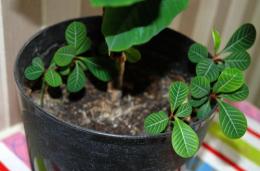
Knowledgeable people say that white-veined milkweed can attract harmony in the family and bring prosperity and prosperity to the house. Feng Shui experts say that such a plant protects the home from the invasion of evil forces, so they place it near the front door. If you place it near a TV or computer, it will neutralize the harmful radiation emanating from them during operation.
Content:
Botanical characteristics
Many people call milkweed a white-veined cactus, and in some ways they are right. This type of plant belongs to succulents. It is often found in Africa and the subtropics of America.
The plant looks like a small palm tree. Its emerald green leaves are located at the top and have white veins, as the lower ones fall off as they grow. Over time, the fleshy stem takes on the appearance of a real palm tree, which makes the flower even more attractive. If you care for it properly, flowering begins in the second year and lasts throughout spring and summer.
The flowers of milkweed are white-veined. The fruits seem to be collected in boxes. After they mature, seeds “shoot” and scatter in different directions and can end up in pots with other plants.
Content Rules
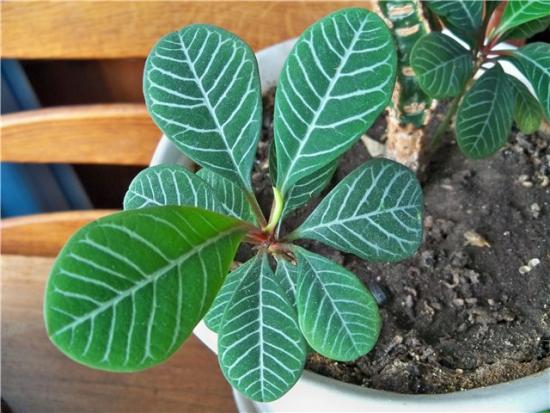
This plant will not be inconvenient to care for; it loves light, fresh air, feels comfortable near heating systems, but is afraid of direct sunlight. In summer, moderate watering is required. The water should not be cold: 18 - 20 degrees is quite enough.
When caring for a flower, it is necessary to monitor the soil moisture; it should not be waterlogged, otherwise the root system will quickly rot. Like all succulents, milkweed goes dormant. in autumn-winter period. Put it in a cool place and limit watering to once a month; in the spring it will thank you for your care by flowering.
From October to the end of March, the plant does not have enough sunlight, so during this period the leaves begin to turn yellow and fall off. Such a natural process does not refer to painful symptoms, and when the first bright sun appears, milkweed tends to come to life again.
With the appearance of new leaves, the flower needs increased feeding. For such purposes, it is better to use a special fertilizing composition for cacti. In spring and summer, fertilizing is carried out up to three times a month, and in winter once with a weakly concentrated solution.
Reproduction and transplantation
White-veined spurge is propagated by seeds or cuttings. In June, when the lateral shoots grow, they are carefully cut off and placed in a vessel with warm water to drain the milky juice. The next day, the cut area must be treated with black activated carbon (sprinkled) and left in this form for 2 - 3 days. When it wilts, you need to plant it in a peat substrate mixed with sand. The optimal room temperature should be 22 - 24 degrees.
For replanting a flower, soil for succulents or a mixture of peat, sand and turf soil (1 part each) is suitable.The acidity of the soil should not exceed the standard indicator: pH 5.0 - 6.0, that is, be slightly acidic.
Since the plant has a superficial root system, it is better to choose a wide and low pot. At a young age, white-veined euphorbia is replanted once a year, adult plants once every 3 years.
The secret of a beautiful plant
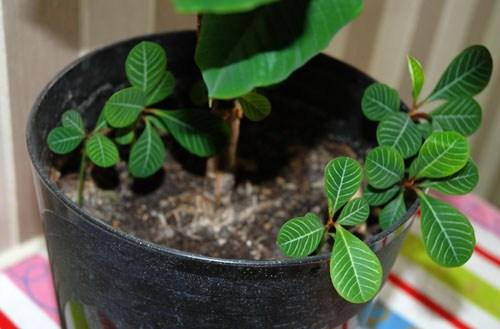
Despite the fact that the flower does not require careful care, a special technology is used to grow it:
- The room should be light all year round.
- Maintain an ambient air temperature of at least +15 °C.
- Avoid drafts and drying out of the soil in the flowerpot.
- After the spurge has completely faded, trim the shoots to 15 cm.
- During the period of intensive growth and ovary of young leaves, the flower must be sprayed from time to time (2 times a week).
- When watering do not pour too much water so that it does not stagnate.
Medicinal properties
There are many different opinions about the dangers and benefits of this plant. All types of milkweed contain a specific milky sap, which, if it comes into contact with the skin or mucous membranes, can cause serious consequences: allergies and severe burns. In some cases - blindness and ulcers. Therefore, it should be handled with care and precision.
Even in ancient times, folk healers used the flower to make all kinds of potions, which were used to rejuvenate the skin, treat paralysis, and wounds that did not heal for a long time. Plant infusions They relieve swelling well, have an emetic, diaphoretic, analgesic, and laxative effect.
In modern medicine, many doctors in their practice also prescribe infusions of milkweed to patients for complex treatment.The unique properties of this plant are effective for hemorrhoids, cystitis, extensive pulmonary lesions and gastrointestinal diseases.
It must be remembered that when growing white-veined milkweed in the house, you must follow certain instructions. This mainly applies to those people who have children and pets.
Interesting video about a popular indoor plant:
Interesting information about the vegetable garden

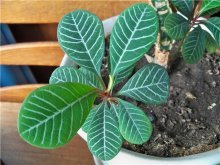
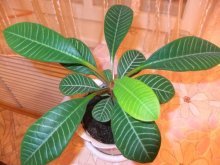
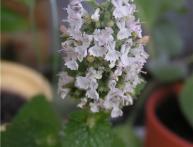
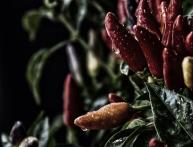
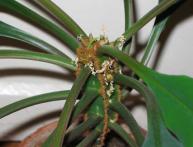
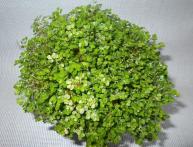

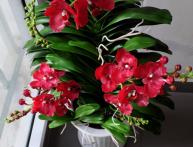

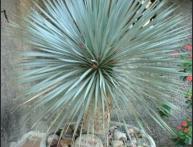
Comments
I don't like this plant. because it “shoots” its seeds into other flower pots and sprouts everywhere. Although, there are probably beautifully flowering varieties of such milkweed. But the most common one, with inconspicuous small flowers, is a real indoor weed!